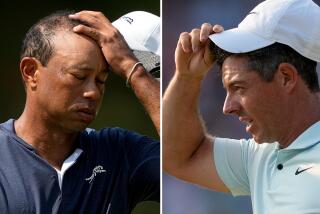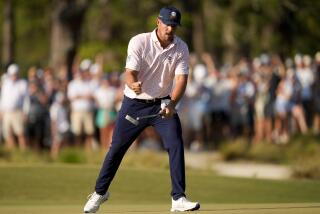An Open Book on U.S. Open
- Share via
SPRINGFIELD, N.J. — It is golf’s greatest prize, the one the great ones have to win and the journeymen dream of winning. The Brits call their open “The Open,” but it is merely older, more venerable. The U.S. Open is harder to win, easier to lose. Most golfers would trade a British Open for it.
The Masters? Prestigious, surely. Not the Freeport-McMoRan Classic. But not the Open, either.
So it convenes for the 93rd time at the ancient testing grounds of Baltusrol this week, a relentless rolling track that has hosted more U.S. Opens than any other in the country. It is a tournament which drips with history. Golf’s finest and most terrible hour at one and the same time, 150 of the game’s finest practitioners up against a foe worthy of their mettle. Here are a few of the things to look out for, to expect:
Don’t bet on any amateur, even if you can-- Only five amateurs have won in its long and complex history, going back to the days when one-third of the field was amateurs. No amateur has won it since 1933, nor is one likely to ever again. But it is interesting that the lowest score ever posted by an amateur, 282, was put up in 1960 by a fellow who finished second to Arnold Palmer that year and of whom Ben Hogan was to say after the final round, “If that kid (age 20) I played with today had a brain in his head, he would have won by three shots.” The no-brainer was Jack Nicklaus.
Look for the ever-lovin’ headline “Unknown Wins Open’ ‘--It crops up when you least expect it. A nobody named Sam Parks won it in 1935. It was not only the first tournament he had ever won, it was the only one. He beat the long-hitting Jimmy Thomson (the John Daly of his era) by two shots--299-301. Thomson later told me he went on tour with the Open winner, Parks, but the tour aborted after five weeks. “Turns out he could only shoot 75, and that was the year three 75s and one 75 with a birdie at the end won the Open. But nobody in that Depression year was going to pay good money to go out and see a guy shoot 75. They could do that themselves.” The next year, another home pro, Tony Manero, won it, and he won only one other tournament ever. He did, however, break the Open record by four shots to shoot 282. In 1969, the Ol’ Sarge, Orville Moody won the Open, the only tournament he would ever win. But, Orville had spent his formative years as a sergeant in charge of officers’ golf at Far East Army bases. Orville was almost 36 years old when he joined the tour.
If not an unknown, look for the nearly known-- When Andy North won it in 1978, he had won only one other tournament, lifetime. He was to win another Open, but he goes down in history as the golfer who won three tournaments lifetime--and two of them were U.S. Opens. Lou Graham was hardly a household name when he won in ’75. He had been on tour 11 years and won only two whistle-stop tour events.
Look for some guys who just seem to be able to handle open tracks-- While the legends of the game seem to have the devil’s own time calming down in Opens, unlikely players handle them coolly and efficiently. Ralph Guldahl, a man of modest talents and accomplishments otherwise (a chronicler said he looked like Dempsey trying to uppercut the ball), always played over his head in an Open. He was second (to Johnny Goodman) in 1933, in the top 10 in two other years--and then won back-to-back in 1937-38. He lost his stroke forever during the war and never made it back. Hale Irwin was a major player. He won 19 tournaments, but three of them were U.S. Opens, which seems a disproportionate amount. The only others who have won it that many times (they all had four) were names like Willie Anderson, Bobby Jones, Ben Hogan and Jack Nicklaus. Curtis Strange, like Guldahl, won back-to-back Opens, then, like Guldahl, seemed to have lost the handle. He hasn’t won anywhere since his last Open victory. The genie went back in the bottle.
Look for the blowup-- The most famous blowup was Sam Snead’s in 1939, an implosion which was probably to guarantee he would never win this event. Playing at Spring Mill in Philadelphia on a course which had a par of 69, lowest in Open history, Snead stood on the 17th tee of the final round, needing only two pars to win the tournament by two shots. He bogeyed No. 17. But a par five on the 18th would still have given him the championship by one shot. Sam topped shots, left a ball in a bunker, went from bunker-to-bunker--did all of the things we weekend hackers do, including three-putt when he finally got on the green. When the blood had been mopped up, Sam had shot what the players call a “snowman.” An 8. Ocho. He never shook that memory. In 1966, Arnold Palmer, who won one Open and lost in a playoff in three others, had a seven-shot lead with nine holes to play at the Olympic Club in San Francisco. Arnold began to play the ghost of Ben Hogan. He needed a 36 on the back nine to tie Hogan’s all-time Open record of 276. Or maybe he just played a typical Arnie’s-Army-Go-For-It round. Whatever motivated him, he squandered strokes like a sailor on shore leave with his pay. He had a five-shot lead with only five holes to play, but when it was over, Billy Casper had tied him and was to beat him in the playoff the next day. As stupendous as they were, these were not the only Open hall of horrors. In 1919, a player named Willie Chisholm, on a 185-yard par-three at Brae Burn, hit his ball down on the rocks. He went down to play it. But all he could raise were sparks as he swiped at the ball 13 times, then took five more to get in the hole. He took an 18 on the hole, an Open record for a par three, but on a par four at Cherry Hills in 1938, a player named Ray Ainslie hit his ball into a shallow creek and kept trying to play it out with a nine-iron. He needed a fishing pole. He holed out in 19, a record one-hole score for an Open.
Don’t bet anybody who’s leading after 18, or even after 36 --The Open has been won by the man who led after 18 holes only 14 times, or about 15% of the time. It’s been won by the player leading after two rounds only about 25% of the time. It has been won by the guy leading after 72 holes 100% of the time. Only four men have led after every round, Hogan, Walter Hagen, Tony Jacklin and Jim Barnes.
Remember, it’s the only sporting event in the world where there are 155 losers--6,271 if you count the guys who tried to qualify and failed. It’s not a sporting event, it’s a tragedy.
With that in mind, play away, gentlemen!
More to Read
Go beyond the scoreboard
Get the latest on L.A.'s teams in the daily Sports Report newsletter.
You may occasionally receive promotional content from the Los Angeles Times.










